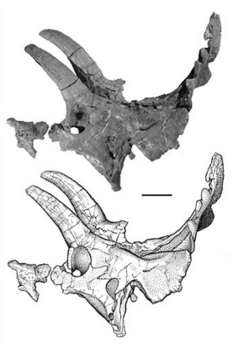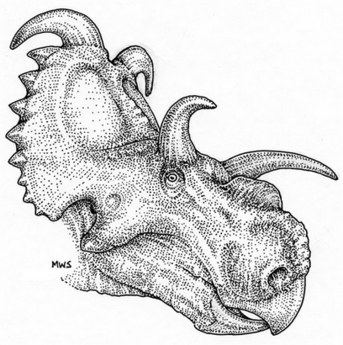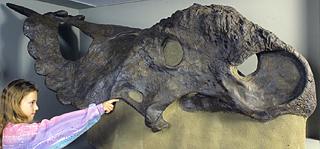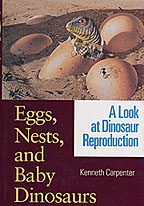I could scarcely hide my frustration when I laid eyes on the bulletin-board announcement; the “Dino Pastor” was coming to my church. Well, not exactly my church (I attended a nightly non-denominational service), but the home church of the services I attended. I promptly ripped down the poster, emblazoned with the image of said man of faith on the back of an oversize dromeosaurid, and later that evening I logged onto the “Declare God’s Wonders” website to see just what I would be up against. In viewing several of the video clips available, the Rev. Paul Veit seemed to employ various slides and rhetorical devices employed by Answers in Genesis, as well as the old creationist stand-by of quote mining. Now even more incised than before (and after conferring with my own church’s staff to make sure I was not unduly rude or polemic in my message) I sent the church’s head pastor a long list of inaccuracies and problems with Rev. Veit’s program, offering to give a corresponding lecture on evolution if he deemed it fit. He did not, and so I found myself sitting a few pews back from the front on a gloomy October Saturday, thumbing through my copy of The Dinosauria, waiting for the kid-oriented lecture to start.
I could go on about the inaccuracies reported by Rev. Veit in his presentation (i.e. that Icthyosaurs were fish; that a columbian mammoth at the Waco, Texas mammoth site was trying to rescue his “wife” from rising mud; that Archaeopteryx may very well be a hoax; etc.), but what initially struck me was a small teddy bear, enriched with minerals, sitting on a table in front of the podium. I do not remember all the details of the bear’s origins, but (if I recall correctly) it fell into an underground spring and remained there for about two years, minerals from the spring seeping into the fabric during that time. While all this teddy seemed to convey was that if you drop one into an underground spring, don’t expect something soft and fuzzy to come back out. Rev. Veit did not see it this way, however; this mineral-fortified child’s toy was proof that fossilization could happen far faster than “secular scientists” claim, and so the bones of dinosaurs really could be less than 10,000 years old. At that point I wanted to approach him, present my left leg, and say “Here’s the other one, why don’t you pull it, too.”
Although Rev. Veit’s little display was entirely wrong about fossils, it did reflect the commonplace misunderstanding of what a fossil is and how it comes to be. During the first lecture of a course on paleontology (as well as one on dinosaurs I had taken with the same professor two years before) one of the first questions that was asked the class was “What is a fossil?” Usually the answers started with “A bone that has been at least partially replaced by rock,” to which is in some sense true but is far too narrow a definition*. After a moment or two someone usually would suggest that eggs, tracks, or shells should be included as well, but what about age? If I found a pig’s rib from colonial America in my backyard, would it count as a fossil? No, not at all (although if I put it back it could, in time).
The answer which the professor revealed (and which I will use as the operation definition for this post) is that a fossil is any preserved trace of a prehistoric organism. The burrows that belie the intense bioturbation of the Inversand Pit in New Jersey are just as much fossils as the mosasaur vertebra I found lying on top of a “junk pile” (a mound of sediment already mined, but usually containing plenty of fossil material), and the exquisitely-preserved frozen-mammoths from Siberia most certainly count as well.

Burrows underlying the end-Cretaceous “Main Fossiliferous Layer” at the Inversand Pit in New Jersey. These burrows are fossils just like a dinosaur bone is a fossil, and the orange color is from iron oxides from the Navasink Formation brought down by water. Photo: Brian Switek
Note that nothing has been said about the level of mineralization, which varies from one fossil to another. Sometimes you find a dinosaur bone and it’s been entirely replaced by minerals; such remains are referred to as being “petrified“, feeling considerably heavier than bone that is often displayed in museums. In fact, sometimes the minerals that incorporate into bone create fossils that are even more valuable than the skeleton itself; in Sea Dragons, author Richard Ellis tells of a skeleton of the plesiosaur Leptocleidus that had been at least partially opalized!
Other times, however, exceptional preservation of soft-parts occurs (see my post on the Solnhofen limestone for more on this) and we are given an unprecedented look at structures or organs normally lost due to taphonomic factors (i.e. scavengers, bacteria, weathering, etc.). Such is the case with a particular Tyrannosaurus rex thigh bone investigated by Dr. Mary Schweitzer which revealed the preservation of some soft anatomy previously unheard of from a dinosaur, and Young Earth Creationists wasted no time using her work to support their own interpretation of a literal Genesis account and a 10,000 year old planet. Paul Humber is one such creationist, and he certainly doesn’t hesitate to condemn scientists or point fingers. In Reason #23, the one I’ll do my best to unravel today, he self-righteously states;
Reason #23: The Bible speaks of those who suppress the truth in unrighteousness. Dinosaur tissue has been extracted from bone fossils and has been found to be both soft and flexible. This was a surprise to the evolutionary scientists studying the fossils; they seem unwilling to admit that this evidence, at least on the surface, seems to support biblical chronology and clashes with evolutionary faith that dinosaurs are millions of years old. If some affirm that it is merely soft, pliable polymer, why do they not go the next step and submit it to AMS testing for C14?
It’s odd that Humber does not mention Mary Schweitzer or the species of dinosaur specifically in his assertion, but didn’t have a problem quoting her out of context in a summary of his book Evolution Exposed on Amazon.com. That point aside, wonderfully preserved dinosaurs are always a marvel but hardly anything new; “mummified” dinosaurs have been known since at least 1912, and many of the dinosaurs coming out of Liaoning, China are well known to exhibit such miraculous fossilization that their feathers leave no doubt as to the evolutionary relationship between dinosaurs and birds. The Schweitzer Tyrannosaurus (or MOR 1125 as it’s known in scientific circles), however, is different in a very special way. Rather than preserving skin impressions or aspects of the soft anatomy etched as a mold or cast in rock, it appears that MOR 1125 had actual tissue inside the marrow cavity of one of its thighbones, although the discovery was made because the bone was reluctantly broken in order to better transport the fossil. What is curious is that it seems part of the “conventional wisdom” that all Hell Creek Formation dinosaur bones (where the Tyrannosaurus was found) have a distinct organic odor to them. In an article about her find in Discover, Schweitzer recalls the following;
“It smelled just like one of the cadavers we had in the lab who had been treated with chemotherapy before he died,” she says. Given the conventional wisdom that such fossils were made up entirely of minerals, Schweitzer was anxious when mentioning this to Horner. “But he said, ‘Oh, yeah, all Hell Creek bones smell,'”
Could it be that there is something about the Hell Creek Formation that has preserved organic material within many of the fossils? I think it’s a fair question to ask, especially if there seems to be an “organic odor” that would signal some level of decay. The problem is that some bones would have to be broken or sliced open to confirm this, something that many paleontologists may be loathe to do (and I don’t necessarily blame them!). Still, perhaps there should be a re-examination of fossils from Hell Creek languishing on dusty museum shelves; surely there are some that could be spared to help determine if this is an isolated phenomena or there is something significant going on in Hell Creek.
Such an observation raises an important point, however; just how fast does fossilization occur? The answer is “Well, it depends.” There are various modes by which fossils can come to be, but rather than write a treatise on fossilization I’ll focus on what is pertinent for dinosaurs. To the best of our understanding, after a deceased dinosaur becomes covered by sediment (it helps if this occurs quickly, as the result of local flooding, a mudslide, a sandstorm, a riverbed/ocean bottom, etc.) mineral-carrying groundwater seeps into the tiny spaces in the organism over time, leaving minerals in those spaces, and so bone is converted into mineral. As hinted at earlier, however, the extent to which this happens varies, sometimes producing entirely mineralized skeletons and other times (as with the Schweitzer T. rex) mineralization is not completed. Fossilization is not an all or nothing process (although many popular books seem to treat it as such), and and so the appearance of tissue in a bone does not automatically render the scientifically established age of the earth to be fraudulent or suggest that Tyrannosaurus munched on coconuts in the Garden of Eden.
So what about the “soft” tissue? Well, Humber makes a very common creationist mistake by asserting that “Dinosaur tissue has been extracted from bone fossils and has been found to be both soft and flexible,” which shows that he did not read Schweitzer’s 2005 paper on her findings. There’s really no excuse; it’s available for free through the website of the journal Science, and the second sentence of the materials & methods section explains that Schweitzer did not stick in her thumb, pull out some Tyrannosaurus soft tissue, and say “Gee what a good girl am I” (and yes, I am aware that Schweitzer began this study under the guidance of paleontologist John “Jack” Horner). The opening of the supplement reads;
Small (0.05-2 inches width) fragments of untreated compact and undescribed (1S) endosteally derived bone tissues were separated from Tyrannosaurus rex (MOR 1125) femur and collected under a hood, using aseptic methods. Tissues were demineralized (0.5M EDTA,pH 8.0) for 7 days, changing buffer daily. Material remaining after demineralization was rinsed with phosphate buffer (PBS, pH 6.8) and imaged using a Zeiss dissecting scope with a digital camera and Axio Vision Software (other dinosaur specimens were demineralized according to this protocol but no further analyses were undertaken for this study).
Rather than putting her hand in a pile of goo, Schweitzer separated the tissues and tried to remove as much mineral material as possible, leaving only the organic material behind. Indeed, this dinosaur (like many) was still in the process of fossilization when extracted from the ground, and there was significant enough mineral material around the tissues for Schweitzer to spend time dissolving them. Given that things were not so simple of Humber suggests, what exactly did Schweitzer find?
First, it should be pointed out that this more recent find is often confused with one Schweitzer made a number of years earlier. In June 1997 Schweitzer published a paper in the Proceedings of the National Academy of Sciences entitled “Heme compounds in dinosaur trabecular bone“, and that paper was seized upon by creationists as well. What the 1997 paper reflects was the discovery of hemoglobin remnants and other degraded material from blood, but not actual hemoglobin or red blood cells.
A similar misunderstanding occurred due to media coverage following the 2005 paper; even I couldn’t quite figure out what exactly was found (or not found). In comparison with prepared ostrich tissues, it seemed that Schweitzer had uncovered corresponding tissues from the dinosaur bone, notably blood vessels and osteocytes, although the authors admit towards the end of the PNAS paper that they could not be sure to what extent the original cell materials were present. It has even been suggested that the remaining material was essentially fossilization at a new level, preserving vessels and cells instead of the more familiar fossilization of large structures.
Two new studies released this year (one by Schweitzer, one by John Asara, both appearing in the same issue of Science), however, point to the preserved tissue being original, at least in part. I initially posted about this story a few weeks ago, and while the studies seem to give stronger evidence for organic material in the bone (and once again confirming the dinosaur-bird link) there is still some amount of uncertainty among scientists as to how reliable the results of the protein analysis are. Yes, what were recognized as collagen proteins were collected and sequenced, but more proteins will have to be sequenced before we can be certain of the results of the studies undertaken by Schweitzer and Asara; while the Tyrannosaurus proteins were closest to those of a chicken, they were also fairly close to frogs and newts (the next matches) when I would have expected crocodiles as the next best match. After I originally voiced this opinion I was told that crocodiles were not in the database for comparison, but hopefully they will be soon as how the Tyrannosaurus protein matches up with that of another archosaur. Regardless of how accurate these studies are, they are certainly blazing a new trail in paleontology, and we would be foolish to discount the studies as this is a new area of research as far as dinosaurs go. Scientists should remain cautious, but the work of Schweitzer and others in the field should be encouraged; the more data we collect the better able we will be to solve the puzzles presented to us in the dinosaur tissue.
So, what then of Humber’s challenge as to why the bones have not been submitted for C14 dating? While Humber asserts that evolutionists somehow control consensus over the age of the earth, nothing could be further from the truth; evolutionary biologists often are not the ones running tests on the age of the earth, nor do they dictate the age of sediments to geologists. Beyond this obvious truth, and the fact that stratigraphy, the relative position of fossils, and radiometric dating all support the late Cretaceous age of Schweitzer’s Tyrannosaurus, Humber’s challenge makes no sense.
In the question prior to the one being addressed (which I will deal with in due time), Humber essentially calls scientists “chicken” for not using the most up-to-date carbon 14 dating techniques; if they’re so sure about their dates, why don’t they submit their fossils for testing? To put this sort of question in context, it would be like me going to a psychic with my brothers and sisters and getting an “aura reading” (or whatever the hell they do in the process of fleecing people) to make sure I was really related to all my siblings even though I’ve lived with them all my life, seen them the day they were born, have the independant observations of anyone who knows my family, and share obvious physical characteristics with them. Why would I waste my time and money undergoing a test that isn’t going to work in an attempt to confirm what is already grossly apparent? Carbon 14, even advanced AMS carbon 14 dating, only works with samples about 60,000 years old or less; if we dated a dinosaur bone of course we’d get faulty number back, which creationists would probably claim proves their point. I have to track the paper down, but I recently spied a CRSQ paper claiming to use carbon dating techniques to determine the age of a dinosaur bone, and so the “scientist” apparently undermind their own effort by picking a technique that he must have known would give him “young” (and wrong) dates!
The age of the Schweitzer rex isn’t based upon just one radiometric test, but many independent radiometric tests using various methods as well as paleontologists climbing all over the Hell Creek Formation for a century; if there was some big controversy about how old the formation was (or if it really was 10,000 years old or less) why has no one but the creationists mentioned it? I find it hard to believe that so many scientists over so long a time would all be “in” on a cross-disciplinary conspiracy to keep evolution firmly established in society, and if we are to dismiss the work of hundreds (if not thousands) of chemists, physicists, geologists, paleontologists, and biologists who know the Hell Creek Formation well, why not throw science as a whole out the window as well? No, creationists know such a move would be suicide, so they will continue to try and be backseat drivers to the rest of the scientific community, but I doubt anyone is going to stop and listen to their directions.
Once again, Humber seems to have based his argument on faulty assertions and popular articles rather than examining the papers for himself. Sure, he’ll be quick to claim that Schweitzer’s work supports his own worldview, but if Humber really has read the PNAS and Science papers he either did not understand them or chose to ignore their contents; I’ll leave you to decide which is worse.
For an in depth review of other professional creationists trying to take on Schweitzer’s work, check out Gary Hurd’s TalkOrigins piece “Dino Blood Redux”
*In past centuries, however, fossils were considered to be anything that came out of the ground (the word means “dug up” in Latin), and so various rocks, rocks that looked like certain parts of the human anatomy, bones, shells, and nearly anything else that had been underground for some time were called “fossils.”


















Recent Comments